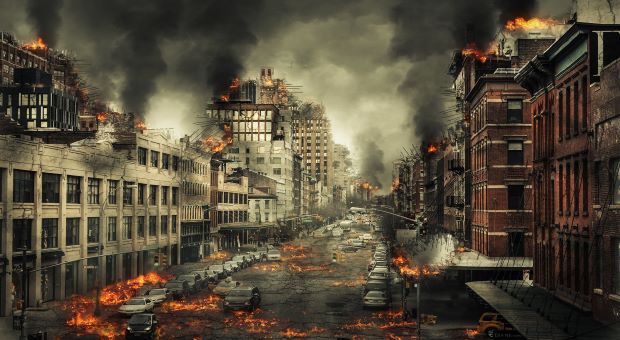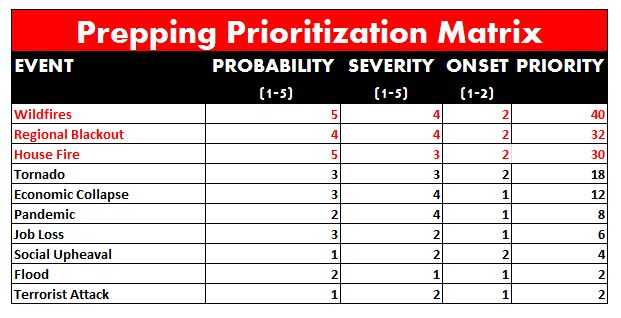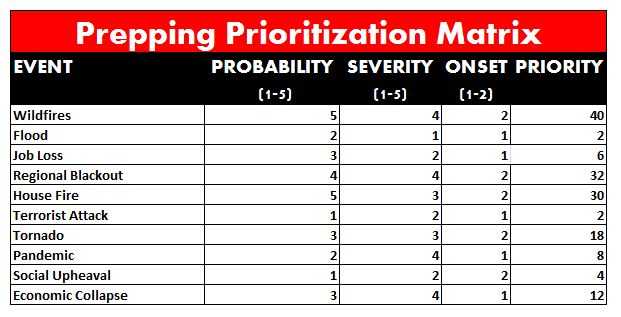Lately, we see a lot of people trying to prepare as best as they can for whatever SHTF scenario they envision.
However, the main question for which they always have to figure out an answer is, “ What should I first prepare for?”
Unfortunately, the answer to this question is never easy, and not only beginners have to figure it out, but also advanced, more experienced preppers. Read forward, and I guarantee that this article will provide some clarity and help you decide what you should prepare for.
Over the years, I’ve helped people prepare and also provided some tips and suggestions that I’ve successfully applied to my prepping plans. However, I always tell my readers that the insights provided may not always work for their particular cases.
Over and over, people ask me the same questions “What do you think we should prepare for?”. Even though they provide me with details about their condition, I’m always telling them to do a threat analysis before they start prepping. The model I’ve been using has helped many people, and I want to share it with as many preppers as I possibly can.
The life of a new prepper
In 90% of the cases, people that start to prepare are told that there are dozens of things they need to buy and that they should do it as soon as possible to make sure they have the proper stuff when the brown stuff hits the fan.
Things like having a bug out bag, a large stock of food and water to last for a few months, and building an armory or whatever in their basement are the most common bits of advice. To the new preppers all of these are overwhelming and confusing, and unfortunately most of them will give up since they can’t wrap their heads around all of it.
Even for the rest of us, oftentimes we have to decide what to do first based on the budget we have and the available time to invest in our prepping plans. The sad part is that most people will toss a coin in the air and let lady luck tell them what to do.
For the determined prepper, there is a better, simpler way to start with all of this. In fact, this technique is used by decision-makers to analyze risk and decide what order they should follow. It’s not a big, hushed up secret, and it is called prioritization.
If you think about it, you are doing this every day of your like, and you prioritize your action based on the situation you have to deal with. Even when you pay your bills you have to prioritize, and you will take care of those who need to be addressed first when you are working with a limited budget. Of course rent and electricity will have priority over food or new clothes.
How to make a threat analysis
Almost ten years ago, I learned a prioritization model when attending a productivity training with the company I was working with. That knowledge stayed with me, and I’ve adapted it to my changing lifestyle.
Ever since then, I developed the habit of dividing my working time into four different quadrants (Q1-Q4). I’ve realized that by doing so, I can help myself to categorize tasks and focus on what is the most urgent and important.
For example, here is how you would apply this if you have a desk job:
Q1
These are the important and urgent tasks you need to take care of. Maybe there is a crisis with an unsatisfied client, or maybe you have a pressing deadline. These are the type of tasks that cannot be finished if you don’t have a risk management plan. For these tasks, you spend most of the time trying to reduce the damage or figure out a temporary solution.
Q2
These are important but not urgent tasks. The things you often do during a normal working day. Things like planning a project, identifying or preventing a project blocker, networking and so on. These require most of your time and concentration, and overall, these are the tasks that increase productivity.
Q3
These are urgent but not important tasks. Here we can categorize the interruptions we have to deal with due to colleagues or other various reasons. Also, the long (boring) meetings that could have been replaced by a proper lined-out mass email are a perfect example of this categorization. Think of these as the tasks that slow down your productivity or mess up your work schedule.
Q4
Here we have the not urgent and not important tasks. Often called long breaks, these include the time-wasters such as Social media, long coffee breaks and everything that bites a big chunk of time from your working schedule.
The same principles listed above were applied in my case when I started prepping. I realized that I have to determine and decide on what is the most important reason for me to start prepping. Over the years, I’ve optimized this threat analysis to be more coherent, as you will see below.
Most folks fail to realize that the most urgent task may not be the biggest task when it comes to prepping, and relatively small tasks may need to be completed before anything else. This is why you need to know how a threat analysis works and learn to make one.
Understanding the formula for building a threat analysis
Every manager, regardless of the field he or she may be working in, uses two main factors when it comes to evaluate and prioritize risks and actions. These factors are probability and severity.
The probability factor calculates how likely it is for something to occur, and the severity factor established the magnitude of the impact if that “something” occurs. These two components are a good start, but a prepper will need a third factor to figure out what to prepare for.
In our case, the third factor is onset, which covers the lead time, if any, you may have to prepare for the SHTF event.
If you assign a numerical value to these factors, you can calculate a number that will help you establish the priority for said SHTF event. For example, if you live in California and you have to decide if you should prepare for wildfires or for a pandemic. You will likely pick the wildfires over the pandemic.
While the severity can be just as bad for both SHTF events and can happen without a prior warning, history has shown us that wildfires have a much higher chance of occurring than a pandemic.
To keep it simple here is the formula you should be using when deciding what to prepare for:
Priority = Probability X Severity X Onset
If you follow this logic, you can make a list of things that can affect you personally and would cause disturbance in your community. After that you can move up to state and even regional scenarios. Closing the list with national and international events such as a nuclear war would be the last logical step.
You can build your own prioritization matrix based on the threats that you feel might affect you. Below you can see a prioritization matrix that one of my friends made for his family living in California.
After you fill the matrix, as you can see above, you can sort the scenarios by priority. This will allow you to order the events by rank, showing you what you should prepare for first, second and so on.
After you have your top 3 scenarios to prepare for, you can use all your resources to cover those scenarios and make sure you have everything you need to face them. There will be situations where there is more than one threat competing for your attention, but you shouldn’t despair. The best thing about emergency preparedness is that the preparations you make and the resources you accumulate for one scenario can be used for other scenarios as well.
When you build a prepping matrix, you need to use common sense and logic for the main scenarios that compete for your attention. Acting upon the scenario should be done based on the time you have.
To give you a quick example, let’s say you wake up in the middle of the night to the sound of a home invasion.
What do you do first in this scenario?
- Do you deal with the intruders?
- Do you call the police?
- Do you get everyone to safety?
As you can see in this scenario, probability, severity, and onset are all at their highest safety.
Here is what logic and common sense tell us to do in such scenario:
- Do whatever it takes to separate your loved ones and yourself from the threat. Go to a panic room if you have one or get everyone out of the house.
- If you can’t get everyone to safety, you will need to minimize or even neutralize the threat. Barricading yourself in a room and using your firearms to make the invaders run away would be the main option here. The second option would be to stop the home invaders for good, but this can also lead to you getting injured or worse.
- Any other action can wait for later after the threat has been neutralized. Things, like calling the police department or asking your neighbors for help, can wait or can be done by your other family members if they are able to do so.
The same logic can be applied to almost all SHTF events you might have to face, and the course of action depends on prioritization.
A last word
The information in this article can help you identify various scenarios you should be preparing for. It will help you organize and prioritize your resources for the threads you identified as being the most probable one for you and your loved ones.
The prepping matrix can always be updated based on what you identify as a new possible threat. Based on how fast times are changing, you can always shift gears to work on something else.








































































I began prepping for hurricans, then added a little more. Now I also include the grandkids when I think of what to have. You don’t have to be overwhelmed. Just a little at the time.
Bob, that is the best prioritization/planning advise I have ever seen on Survivopedia or any other prepper site. Thank you for sharing your insights on planning.
Ron
Threat analysis is all good and well, and I have no issue with this article. But it is just another way of saying that you need to prepare for job loss, the weather events most common to your area, a home fire, catastrophic illness.. Once you are prepared for local, personal events, you already have a leg up on the average person should a wider SHTF event. THEN you can look at the TEOTWAKI type events. I am not a numbers geek (and have nothing against those who are!) but threat analysis is not necessarily the best first approach for most newbie preppers. No offense intended, Bob, this was a great article.
This is a great idea, but I have a question as to the Onset categories, you explained it as how much lead time with a specific event or scenario need and I’m not sure if I understand what you mean by “lead time”. Does that mean how long it will take to fully prepare for it or how long it will take to initiation a plan should that event occur? Thanks for the matrix chart to help us organize this, I’ve been trying for years to create something like this but couldn’t find the right method that worked for me or my situation, it also helps when trying to explain this to none preppers or ones on the fence. Best Wishes!